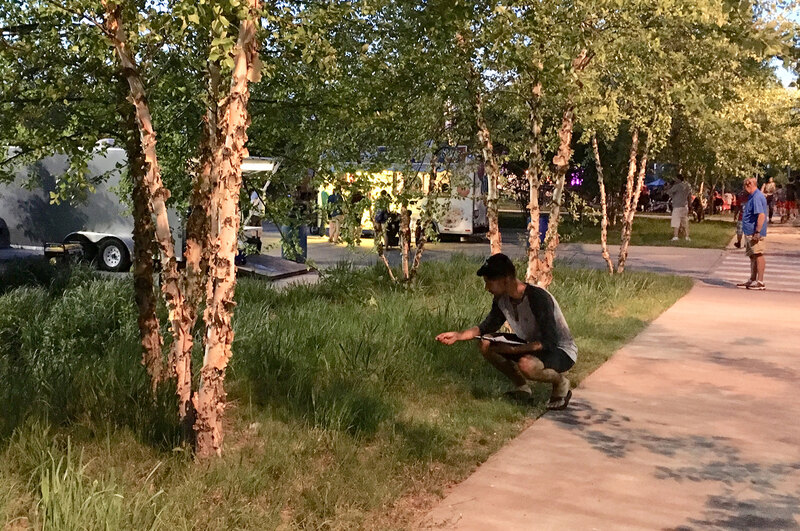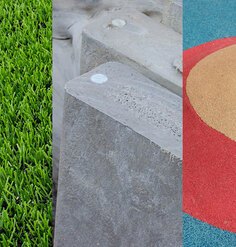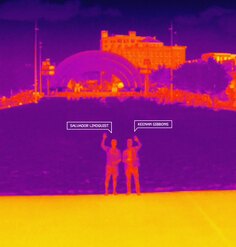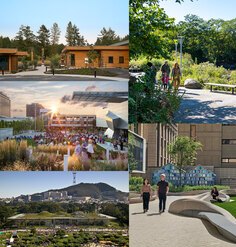From the Field: Shining a Spotlight on Landscape Performance in the Great Plains
By Hannah LoPresto and Brandon Zambrano, BLA Candidates, University of Nebraska-Lincoln

Participating in LAF’s 2018 Case Study Investigation program has been an incredibly informative experience for our research team at the University of Nebraska-Lincoln. We have just completed our second year as undergraduates in the landscape architecture program and are excited to continue learning about landscape performance as Research Assistants under the guidance of Research Fellow Assistant Professor Catherine De Almeida. We are eager to shine a spotlight on the landscape performance of two Great Plains projects: P Street Corridor by Design Workshop, a revitalized downtown streetscape in Lincoln, Nebraska, and Tom Hanafan River’s Edge Park by Sasaki, a waterfront redevelopment in Council Bluffs, Iowa. Working on the post-occupancy study of both parks has been extremely beneficial in understanding how reclaiming underutilized sites can create high-performing landscapes.
Over the course of our study, we’ve discovered many commonalities between the P Street Corridor and Tom Hanafan River’s Edge Park. With both sites located in the Great Plains, participating in the Case Study Investigation program has given us the opportunity to provide recognition and visibility to innovative constructed projects in a region that typically goes unrecognized. Both are public projects in urban settings with primary goals of transforming formerly unpleasant, underused spaces to grant increased public access. Along with public access, stormwater management strategies are essential aspects of both projects. P Street focuses on runoff capture and reduced irrigation cost for roadside bioswales. Tom Hanafan focuses on opportunities to preserve and restore riparian forest in a floodplain to withstand an immense, 500-year storm event.
Although we’ve observed many commonalities between these two projects, each has numerous unique aspects of its own. With P Street located adjacent to the university, our research team was already familiar with the site, having visited and passed through on countless occasions. However, much of what we learned about the P Street project was beyond what we had experienced on site. P Street’s redesign was undertaken by a remote design firm and then passed to a local Lincoln firm for construction administration. This gave us the opportunity to understand the working relationship between a remote design firm and a local firm, revealing the trade-offs that come with this approach. The P Street project was also unique in the amount of recorded baseline data. Our team was pleasantly surprised to learn how extensive the design firm’s baseline data collection was, covering aspects such as user perception, impervious surfaces, and property values. While developing the master plan, the design firm implemented a community engagement process that provided excellent baseline data for our research team to develop our assessment of the project’s social benefits. Our team has been able to replicate the design firm’s pre-project survey (with a few additions of our own) to collect post-occupancy data in order to make a direct comparison of user perception before and after the corridor redesign.
Unlike P Street’s renovated streetscape, our study of Tom Hanafan River’s Edge Park is focused on the reclamation of the Missouri River floodplain for native ecological riparian communities and human access to the river. Some key elements that illustrate this are the revitalization of the riparian forest with native trees along the northern and southern areas surrounding the park’s open space, and a native meadow mix planted along the Army Corps of Engineers’ levee-turned-amphitheater. In conversations with our firm liaison, we were surprised to learn about the pre-existing conditions of the site and how the landscape had been previously deteriorated due to ATV use and invasive species that affected the riparian forest’s growth. Tom Hanafan River’s Edge Park converted a landscape of misuse to a friendly, highly accessible public park. Our team was also surprised to find out that the 2011 Missouri Flood happened during construction of the park. Even though this caused a significant delay, the firm managed to gather data from the occurrence and interpret it into qualitative diagrams in order to show the client how Tom Hanafan River’s Edge Park proposed grading changes that would withstand a 500-year storm event. The design team turned something negative like the 2011 Missouri Flood, analyzed it, and interpreted it positively into the design of the site. We plan to further quantify the quality of the park in our user surveys.
As our research team nears the final stretch of the Case Study Investigation program, we look forward to collecting, documenting, and analyzing our data for these two Great Plains projects. We are especially excited to experiment with a few specific techniques such as on-site percolation tests, surveying users on-site, and mapping economic change in the surrounding areas. Learning from these data collection techniques and communicating with our firm partners and municipal clients has given us an incredible opportunity to grow as landscape architecture students and experience the growing necessity of using landscape performance to quantify the sustainable benefits of landscape architecture.
The University of Nebraska-Lincoln Research Assistants Hannah LoPresto and Brandon Zambrano and Research Fellow Catherine De Almeida are participating in LAF’s 2018 Case Study Investigation (CSI) program, which supports academic research teams to study the environmental, economic, and social performance of exemplary landscape projects. Any opinions expressed in this article belong solely to the author. Their inclusion in this article does not reflect endorsement by LAF.














